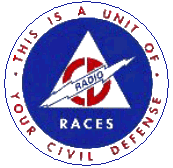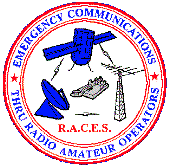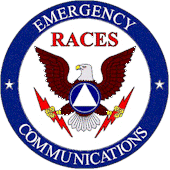





(a) The definitions of terms used in Part 97 are:
(37) RACES (radio amateur civil emergency service). A radio service using amateur stations for civil defense communications during periods of local, regional, or national civil emergencies.
(a) * * *
(3) Communications in which the station licensee or control operator has a pecuniary interest, including communications on behalf of an employer, with the following exceptions:
(i) A station licensee or control station operator may participate on behalf of an employer in an emergency preparedness or disaster readiness test or drill, limited to the duration and scope of such test or drill, and operational testing immediately prior to such test or drill. Tests or drills that are not government-sponsored are limited to a total time of one hour per week; except that no more than twice in any calendar year, they may be conducted for a period not to exceed 72 hours.
* * * * *
A station in, or within 92.6 km (50 nautical miles) of, Alaska may transmit emissions J3E and R3E on the channel at 5.1675 MHz (assigned frequency 5.1689 MHz) for emergency communications. The channel must be shared with stations licensed in the Alaska-Private Fixed Service. The transmitter power must not exceed 150 W PEP. A station in, or within 92.6 km of, Alaska may transmit communications for tests and training drills necessary to ensure the establishment, operation, and maintenance of emergency communication systems.
No provision of these rules prevents the use by an amateur station of any means of radiocommunication at its disposal to provide essential communication needs in connection with the immediate safety of human life and immediate protection of property when normal communication systems are not available.
(a) No provision of these rules prevents the use by an amateur station in distress of any means at its disposal to attract attention, make known its condition and location, and obtain assistance.
(b) No provision of these rules prevents the use by a station, in the exceptional circumstances described in paragraph (a), of any means of radiocommunications at its disposal to assist a station in distress.
(a) No station may transmit in RACES unless it is an FCC-licensed primary, club, or military recreation station and it is certified by a civil defense organization as registered with that organization. No person may be the control operator of an amateur station transmitting in RACES unless that person holds a FCC-issued amateur operator license and is certified by a civil defense organization as enrolled in that organization.
(b) The frequency bands and segments and emissions authorized to the control operator are available to stations transmitting communications in RACES on a shared basis with the amateur service. In the event of an emergency which necessitates invoking the President's War Emergency Powers under the provisions of section 706 of the Communications Act of 1934, as amended, 47 U.S.C. 606, amateur stations participating in RACES may only transmit on the frequency segments authorized pursuant to part 214 of this chapter.
(c) An amateur station registered with a civil defense organization may only communicate with the following stations upon authorization of the responsible civil defense official for the organization with which the amateur station is registered:
(1) An amateur station registered with the same or another civil defense organization; and
(2) A station in a service regulated by the FCC whenever such communication is authorized by the FCC.
(d) All communications transmitted in RACES must be specifically authorized by the civil defense organization for the area served. Only civil defense communications of the following types may be transmitted:
(1) Messages concerning impending or actual conditions jeopardizing the public safety, or affecting the national defense or security during periods of local, regional, or national civil emergencies;
(2) Messages directly concerning the immediate safety of life of individuals, the immediate protection of property, maintenance of law and order, alleviation of human suffering and need, and the combating of armed attack or sabotage;
(3) Messages directly concerning the accumulation and dissemination of public information or instructions to the civilian population essential to the activities of the civil defense organization or other authorized governmental or relief agencies; and
(4) Communications for RACES training drills and tests necessary to ensure the establishment and maintenance of orderly and efficient operation of the RACES as ordered by the responsible civil defense organization served. Such drills and tests may not exceed a total time of 1 hour per week. With the approval of the chief officer for emergency planning in the applicable State, Commonwealth, District, or territory, however, such tests and drills may be conducted for a period not to exceed 72 hours no more than twice in any calendar year.
_____________________________________
_____________________________________
84 Stat. 2083 and E.O. 12472, April 3, 1984, (49 FR 13471; 3 CFR, 1984 Comp., p. 193).
55 FR 51062, Dec. 11, 1990, unless otherwise noted.
The provisions of this part 214 are issued pursuant to Reorganization Plan No. 1 of 1977, 42 FR 56101, 91 Stat. 1633, as amended (5 U.S.C. appendix) and Executive Order 12472. This part 214 replaces Annex 1 of DMO 3000.1, dated November 8, 1963, 28 FR 12273.
The purpose of this part is to provide guidance for the use of the radio spectrum in a period of war, or a threat of war, or a state of public peril or other wartime emergency.
This part covers procedures for the use of radio frequencies upon proclamation by the President that there exists war, or a threat of war or a state of public peril or other wartime emergency or in order to preserve the neutrality of the United States. These procedures will be applied in the coordination, application for, and assignment of radio frequencies upon order of the Director, OSTP. These procedures are intended to be consistent with the provisions and procedures contained in emergency plans for use of the radio spectrum.
When the provisions of this part become operative, Presidential emergency authority, including Executive Order 12656, 12472, 12046 (3 CFR, 1966–1970 Comp., p. 820), and other emergency plans regarding the allocation and use of national resources will be in effect. During an attack, and in a postattack period, the Director, OSTP, will have authority to make new or revised assignments of radio frequencies in accordance with authority delegated by the President.
(a) Whenever it is determined necessary to exercise, in whole or in part, the President's emergency authority over telecommunications, the Director, OSTP, will exercise that authority as specified in Executive Order 12472 (49 FR 13471; 3 CFR, 1984 Comp., p. 193).
(b) In this connection, and concurrently with the war or national emergency proclamation by the President, the Director will:
(1) Authorize the continuance of all frequency authorizations issued by the National Telecommunications and Information Administration (NTIA) and the Federal Communications Commission (FCC), except as they may otherwise be modified or revoked by the Director, OSTP, in the national interest;
(2) Redelegate to the Secretary of Defense the authority necessary to control the use of the radio spectrum in areas of active combat, where such control is necessary to the support of U.S. military operations;
(3) Close all non-government radio stations in the international broadcasting service as defined in the FCC rules and regulations, except those carrying or scheduled to carry U.S. Government-controlled radio broadcasts.
(a) The Director, OSTP, will issue such policy guidance, rules, regulations, procedures, and directives as may be necessary to assure effective frequency usage during wartime emergency conditions.
(b) The FCC, in coordination with NTIA, shall issue appropriate rules, regulations, orders, and instructions and take such other actions not inconsistent with the actions of the Director, OSTP, and the NTIA Emergency Readiness Plan for Use of the Radio Spectrum as may be necessary to ensure the effective use of those portions of the radio spectrum shared by Government and non-governments users.
(c) The FCC shall assist the Director in the preparation of emergency plans pursuant to section 3(h)(3) of Executive Order 12472.
(d) Each Federal Government agency concerned shall develop and be prepared to implement its own plans, and shall make necessary preemergency arrangements with non-government entities for the provision of desired facilities or services, all subject to the guidance and control of the Director.
(a) The frequency management staff supporting the Director, OSTP, comprised of predesignated personnel from the frequency management staffs of the government user agencies, NTIA and the FCC, will have proceeded to the OSTP relocation site in accordance with alerting orders in force.
(b) Government agencies having need for new radio frequency assignments or for modification of existing assignments involving a change in the frequency usage pattern shall, unless otherwise provided, submit applications therefor to the Director, OSTP, by whatever means of communication are available and appropriate, together with a statement of any preapplication coordination accomplished. The Director, OSTP, will review such applications accomplish the necessary additional coordination insofar as practicable, consider all pertinent views and comments, and grant or deny, as he shall determine, the assignment of such frequencies. All concerned will be informed promptly of his decisions.
(c) Non-Government entities having need for new radio frequency assignments or for modifications of existing assignments will continue to submit applications therefor to the FCC, or in accordance with FCC instructions. Such applications shall be coordinated with the Director, OSTP, and granted subject to the approval of the Director, OSTP, or his delegate.
(d) All changes of radio frequency usage within U.S. military theaters of operation will be coordinated with the Director, OSTP, where harmful interference is likely to be caused to stations authorized to operate within the United States and its possessions.
(e) Where submission to the Director, OSTP, is impracticable, the applicant shall:
(1) Consult the NTIA Emergency Readiness Plan for use of the Radio Spectrum and the Government Master File;
(2) Accomplish such coordination as appropriate and possible;
(3) Act in such manner as to have a minimum impact upon established services, accepting the responsibility entailed in taking the temporary action required;
(4) Advise the Director, OSTP, as soon as possible of the action taken, and submit an application for retroactive approval.
© Copyright 1997-2020. All rights reserved. No HTML nor original artwork may be
reproduced or used without written express permission .
Webmaster: Ken Bourne, W6HK
Last Update: June 9, 2020